The 72nd Annual Convention of the Japanese Psychological Association 2008
Hokkaido University, Sapporo, Japan
Workshop No.005 "Experimental studies of anomalous motion illusions"
September 19, 2008
Optimized Fraser-Wilcox illusions
A pictorial classification by Akiyoshi Kitaoka
since September 12, 2008
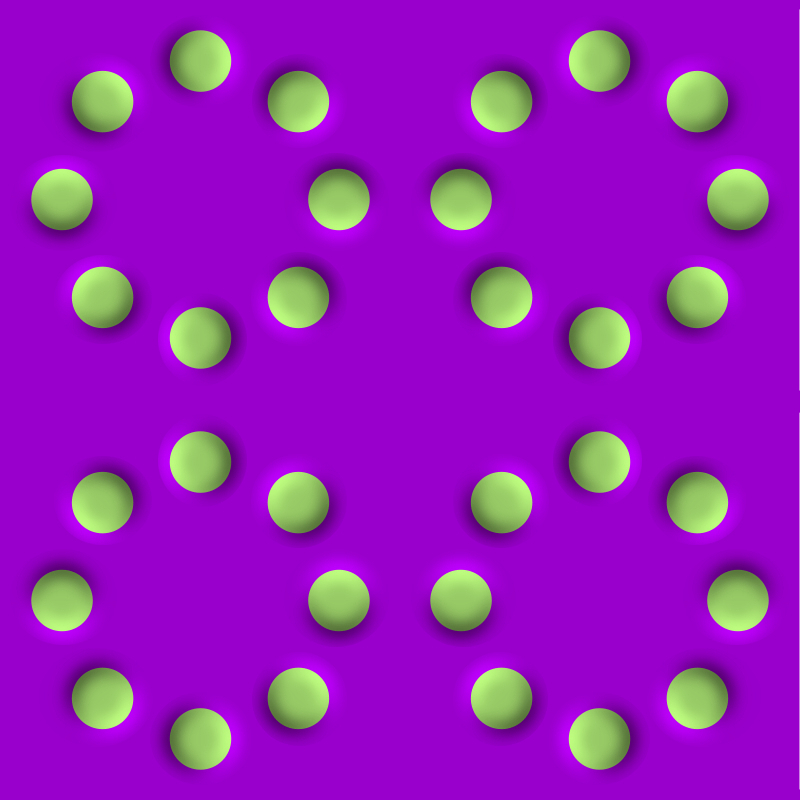
"Rotating
beans"
Each ring appears to rotate.
Copyright Akiyoshi Kitaoka 2008 (September 12)
| Type | Basic illusion that motion direction is from dark to light |
Basic illusion that motion direction is from light to dark |
Examples (click the thumbnail) |
| 0 | 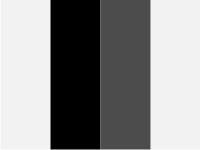 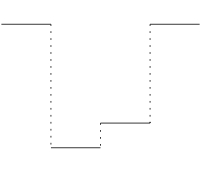 Luminance profile |
 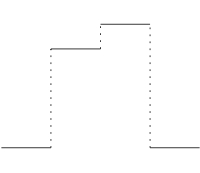 |
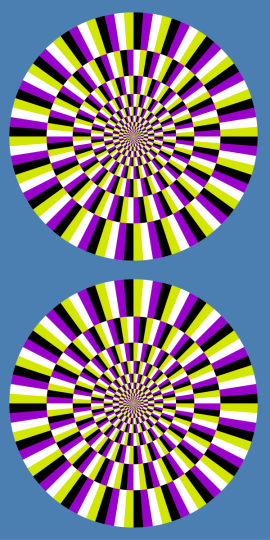 |
 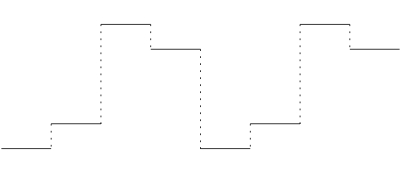 |
|||
Kitaoka, A. and Ashida, H. (2003) Phenomenal characteristics of the peripheral drift illusion. VISION (Journal of the Vision Society of Japan), 15, 261-262. PDF
| Type | Basic illusion that motion direction is from dark to light |
Basic illusion that motion direction is from light to dark |
Examples (click the thumbnail) |
| I | 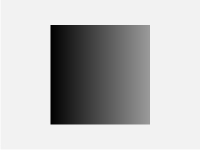 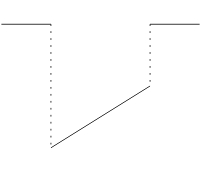 |
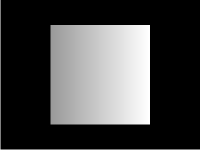 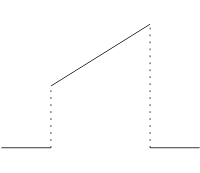 |
|
| IIa |  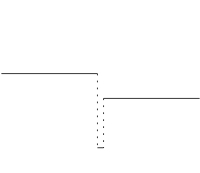 |
 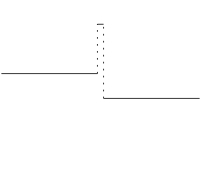 |
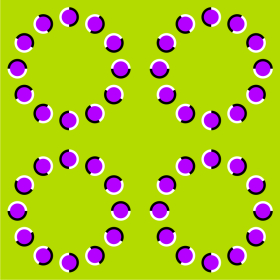 |
| IIb |  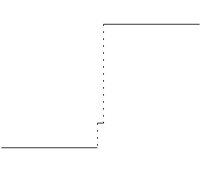 |
 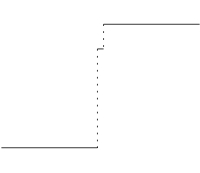 |
|
| III |  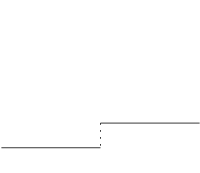 |
 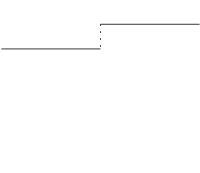 |
|
| IV new! |
 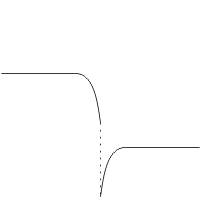 |
 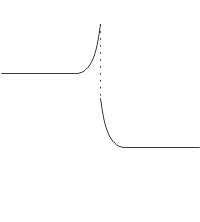 |
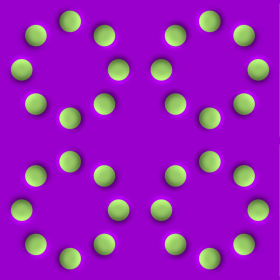 |
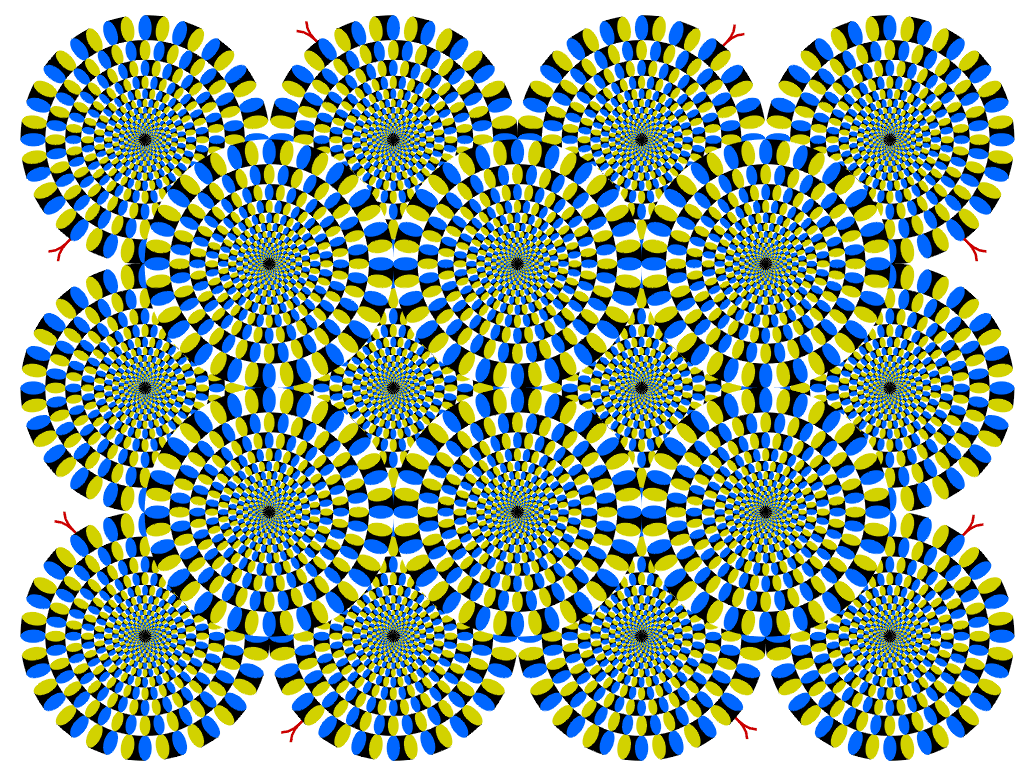
"Rotating snakes"
Circular snakes appear to rotate 'spontaneously'.
Copyright A.Kitaoka 2003 (September 2, 2003)
1. Fraser and Wilcox (1979)
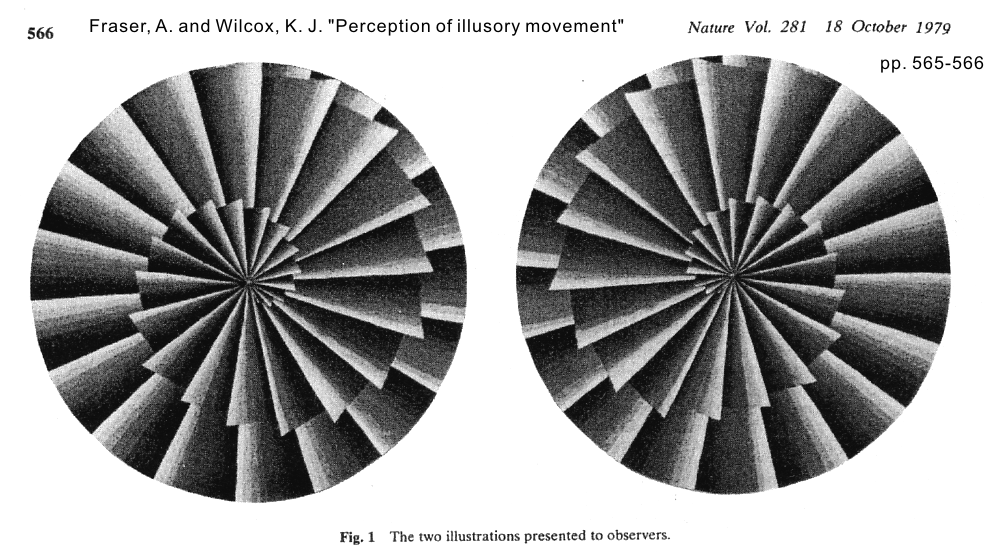
Fraser, A. and Wilcox, K. J. (1979) Perception of illusory movement. Nature, 281, 565-566.
2. Faubert and Herbert (1999)
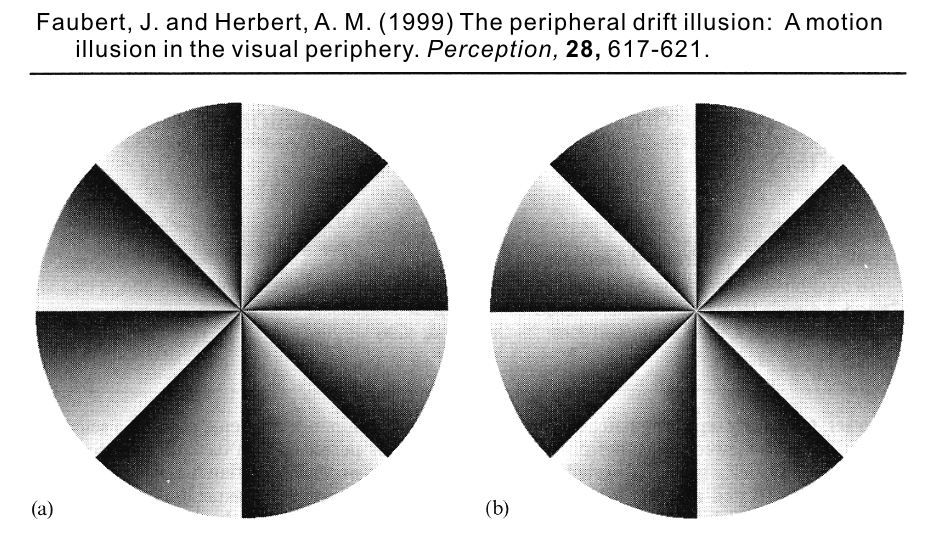
Faubert, J. and Herbert, A. M. (1999) The peripheral drift illusion: A motion illusion in the visual periphery. Perception, 28, 617-621.
3. Naor-Raz and Sekuler (2000)
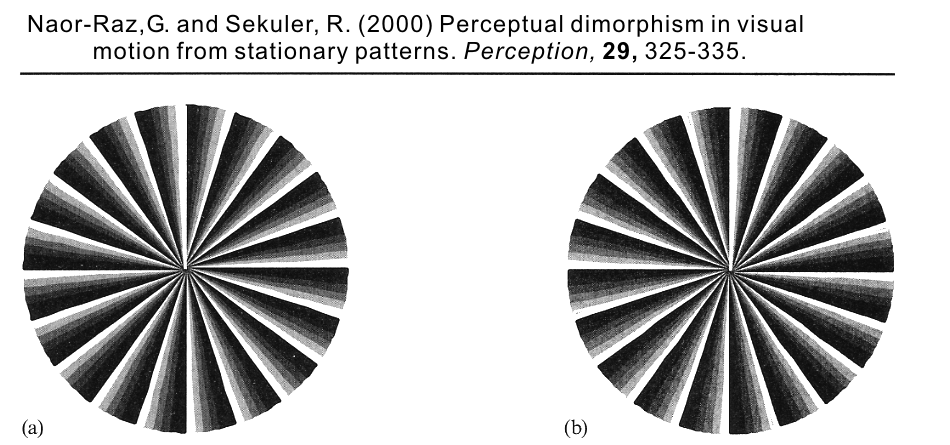
Naor-Raz, G. and Sekuler, R. (2000) Perceptual dimorphism in visual motion from stationary patterns. Perception, 29, 325-335.
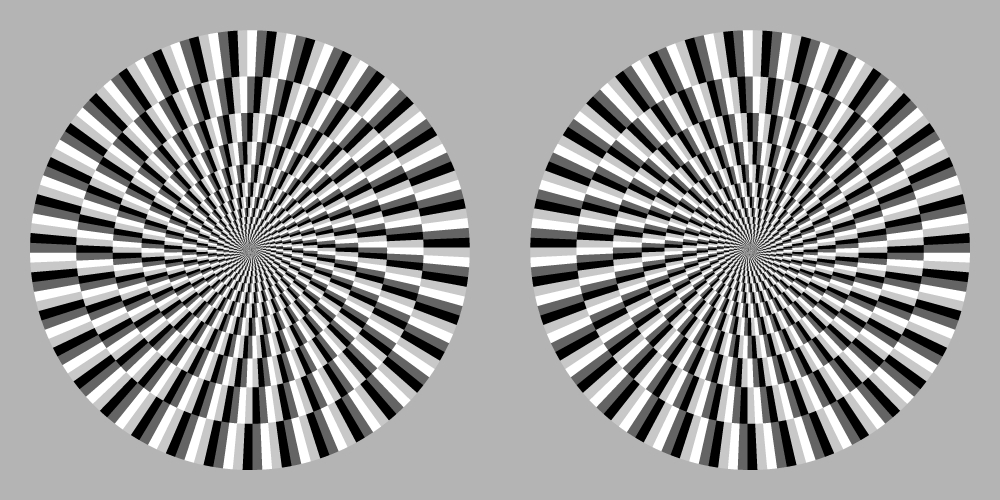
Kitaoka, A. and Ashida, H. (2003) Phenomenal characteristics of the peripheral drift illusion. VISION (Journal of the Vision Society of Japan), 15, 261-262
5. Following papers or articles
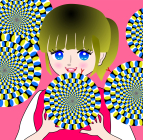 A paper on the "Rotating snakes" illusion has been accepted
for publication in Vision Research! <June 21, 2008>
A paper on the "Rotating snakes" illusion has been accepted
for publication in Vision Research! <June 21, 2008>
Hisakata, R. and Murakami, I. (2008) The effects of eccentricity and retinal illuminance on the illusory motion seen in a stationary luminance gradient. Vision Research, in press
Rumi's page --- Ikuya's page
![]() Related references
Related references ![]()
Chi, M-T., Lee, T-Y., Qu, Y., and Wong, T-T. (2008) Self-Animating Images: Illusory Motion Using Repeated Asymmetric Patterns. ACM Transaction on Graphics (Proceedings of SIGGRAPH 2008), 27, No.3. SIGGRAPH2008 --- Authors' page --- PDF (SIGGRAPH)
Scientific American Reports Special Edition on Perception (2008). ![]()
Kitaoka, A. and Ashida, H. (2007) A variant of the anomalous motion illusion
based upon contrast and visual latency. Perception, 36, 1019-1035. ![]() PDF request to Akiyoshi Kitaoka
PDF request to Akiyoshi Kitaoka
Newton Press (Ed.), A. Kitaoka (Supervisor)
(2007) Newton magazine book: Special
issue "How is the brain deceived? Perfect demonstration of visual
illusions" Tokyo: Newton Press (in Japanese; published in October 2007). ![]()
Ramachandran, V. S. and Rogers-Ramachandran, D. (2007) A Moving Experience: How the eyes can see movement where it does not exist. Scientific American Mind, February/March, 14-16.
Kitaoka, A. (2007) Phenomenal classification of the goptimizedh Fraser-Wilcox
illusion and the effect of color. Poster presentation in DemoNight, VSS2007,
GWiz, Sarasota, Florida, USA, May 14, 2007. 
Murakami, I., Kitaoka, A. and Ashida, H. (2006)
A positive correlation between fixation instability and the strength of illusory
motion in a static display. Vision Research, 46, 2421-2431. ![]() PDF request
should be sent to Dr. Murakami
PDF request
should be sent to Dr. Murakami
Kitaoka, A. (2006) Anomalous motion illusion and stereopsis. Journal of Three Dimensional Images (Japan), 20, 9-14. PDF (manuscript but the same as the printed one)
Kanazawa, S., Kitaoka, A. and Yamaguchi, M. K. (2006) Infants see the gRotating Snakeh illusion. Dorsal and ventral streams in the visual system (Talk): Monday, 21 August 2006; 12:00-12:30 (29th European Conference on Visual Perception, St-Petersburg, Russia, 20th-25th August, 2006) Abstract
Kitaoka, A., Ashida, H., and Murakami, I. (2005) Does the peripheral drift illusion generate illusory motion in depth? Journal of Three Dimensional Images (Tokyo), 19, 6-8. PDF (scanned copy) (poor quality) --- MS-Word file (manuscript, the same as the paper) (high quality)
Conway, R. B., Kitaoka, A., Yazdanbakhsh, A., Pack, C. C., and Livingstone,
M. S. (2005) Neural basis for a powerful static motion illusion. Journal of Neuroscience, 25, 5651-5656. ![]() PDF request should be sent to Dr. Conway
PDF request should be sent to Dr. Conway
Backus, B. T. and Oruç, I. (2005) Illusory motion from change over time in the response to contrast and luminance. Journal of Vision, 5, 1055-1069. http://journalofvision.org/5/11/10/
Ben sent me a T-shirt. <May 30, 2008>
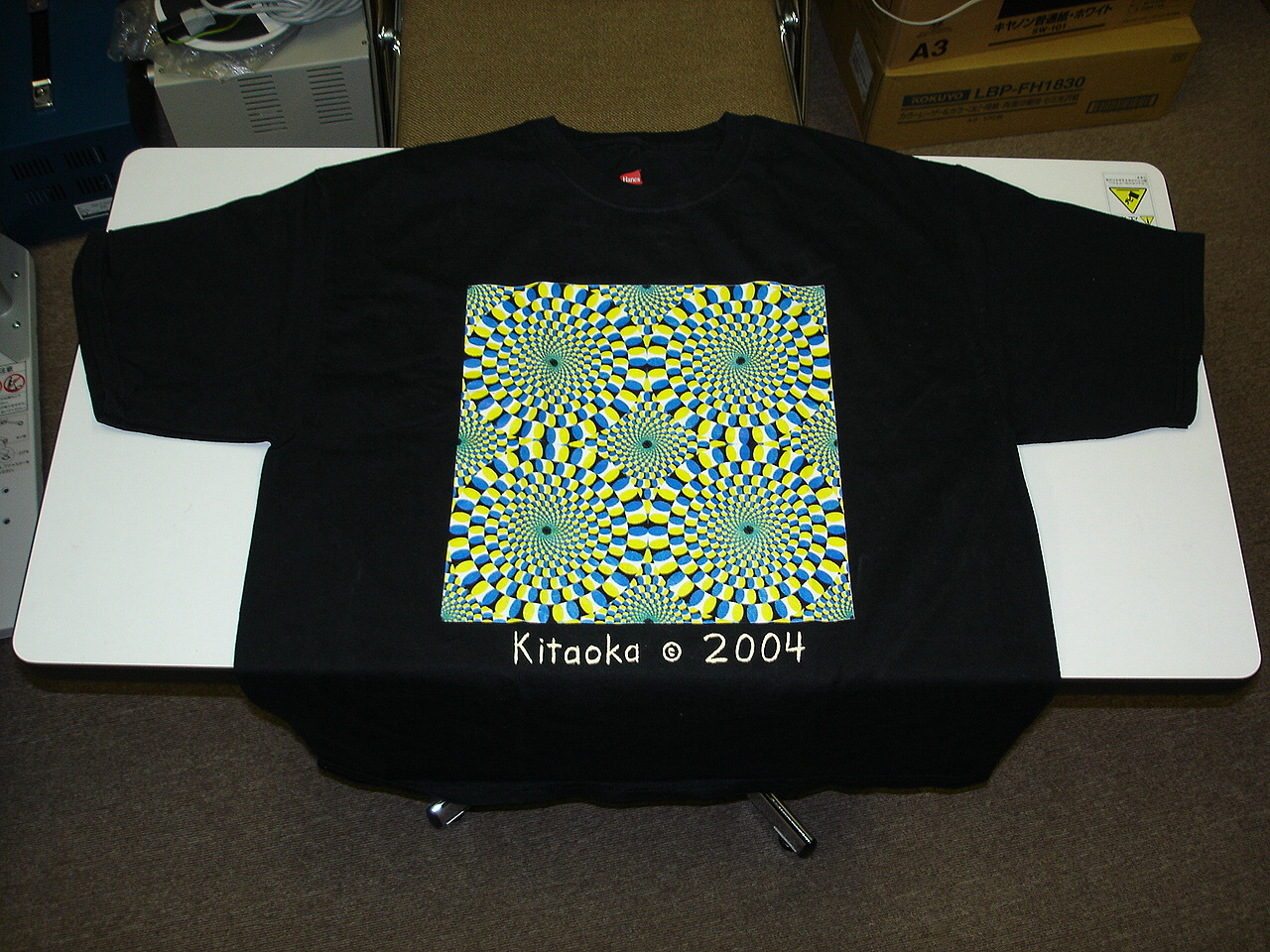
("2003" is correct.)
Actually Irealized this illusion in a design for a Happy New Year card.
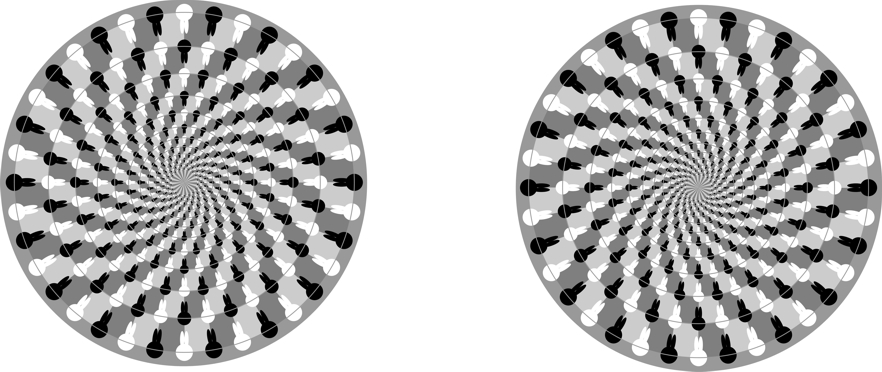
"U-zu"
(A remake)
Rings appear to rotate. This image was originally developed for the spiral illusion, in which the concentric gray lines appear to be a spiral. My nengajo
Copyright A.Kitaoka 2005 (May 23)
| 0 |   Luminance profile |
  |
 |
  |
|||
Kitaoka, A. and Ashida, H. (2003) Phenomenal characteristics of the peripheral drift illusion. VISION (Journal of the Vision Society of Japan), 15, 261-262. PDF
I explain the perceptual dimorphism in motion direction as assuming that two independent illusions are involved in the original Fraser-Wilcox illusion.
| Type | Basic illusion that motion direction is from dark to light |
Basic illusion that motion direction is from light to dark |
Examples (click the thumbnail) |
| I |   |
  |
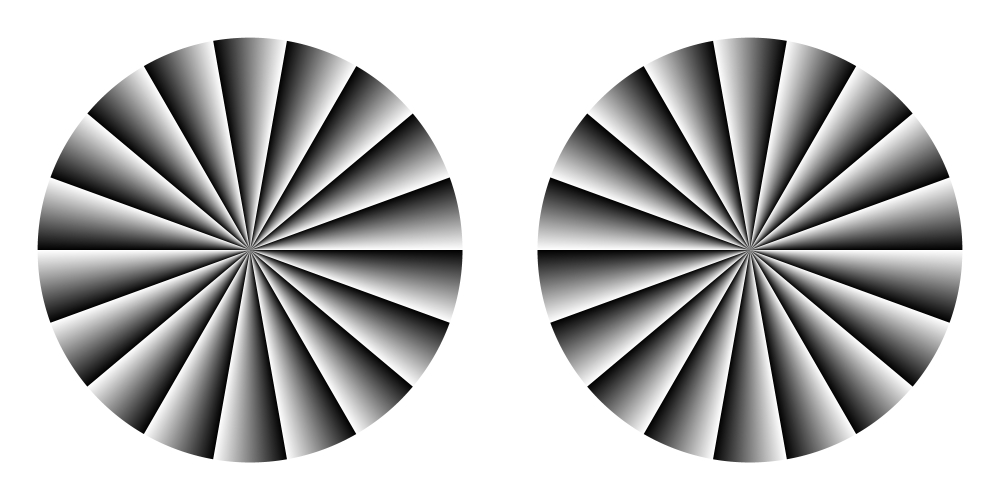
"Dark to light" (in gradation) might be stronger.
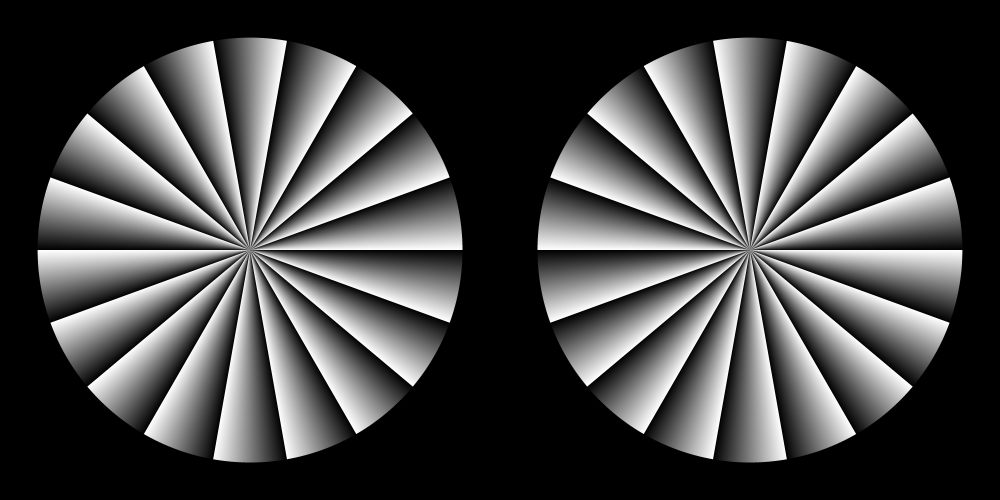
"Light to dark" might be stronger.
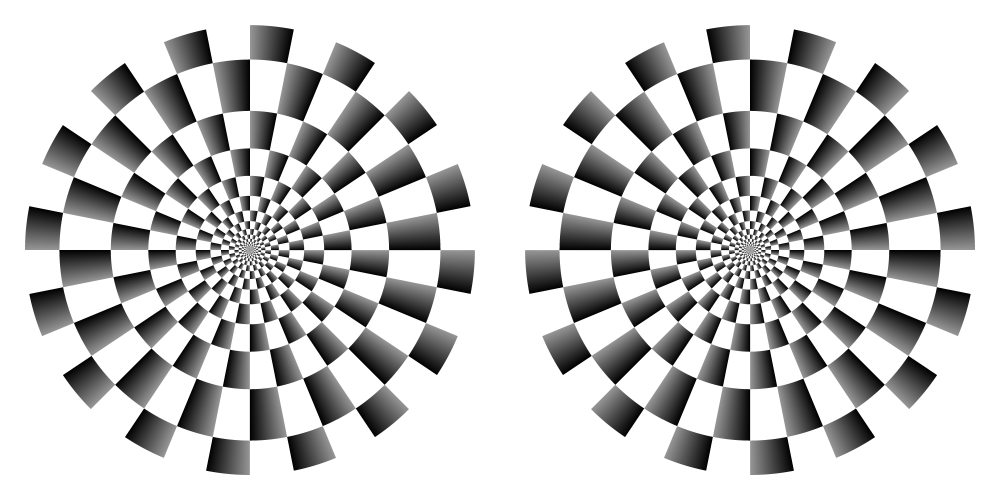
"Dark to light"
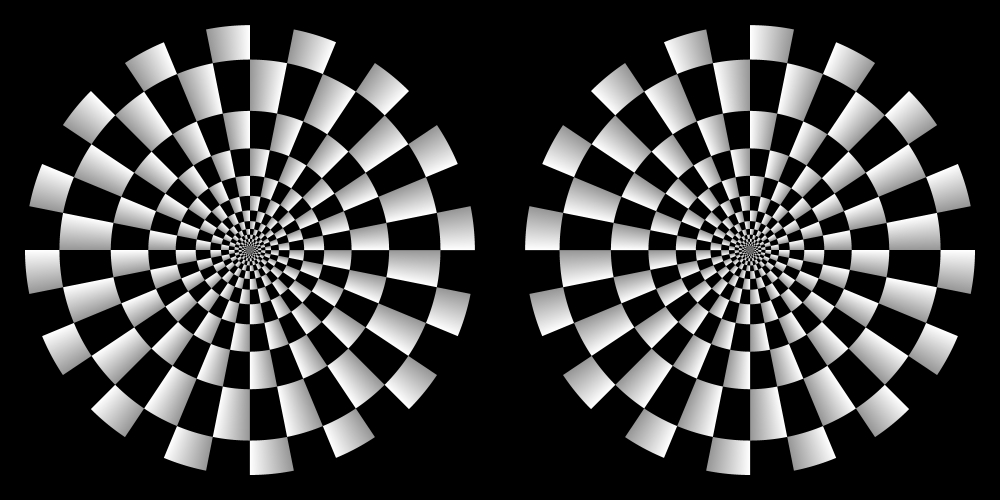
"Light to dark"
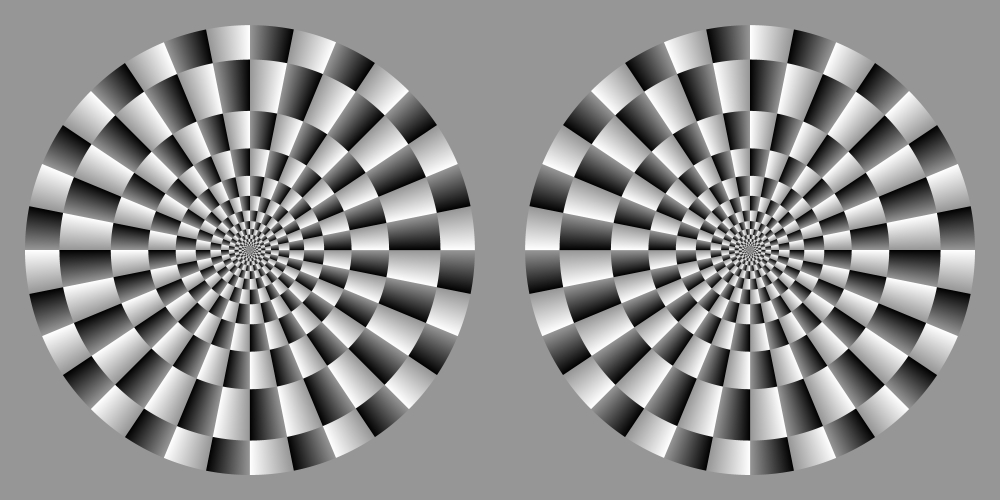
"Dark to light" and "light to dark" in cooperation
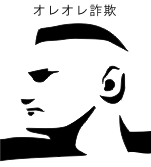 I propose an empirical observation that color might enhance the illusion
in some conditions.
I propose an empirical observation that color might enhance the illusion
in some conditions.
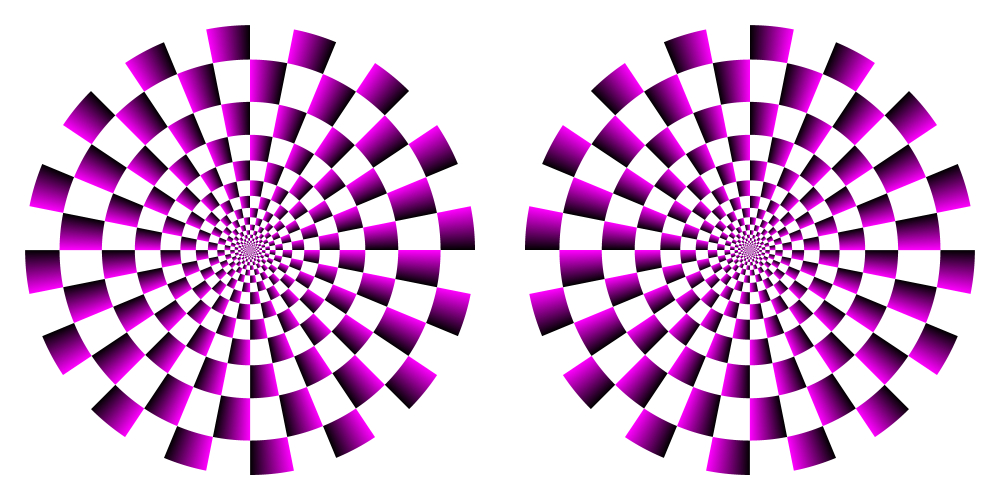
Observation 1. The illusion from dark to light is enhanced by red or blue.
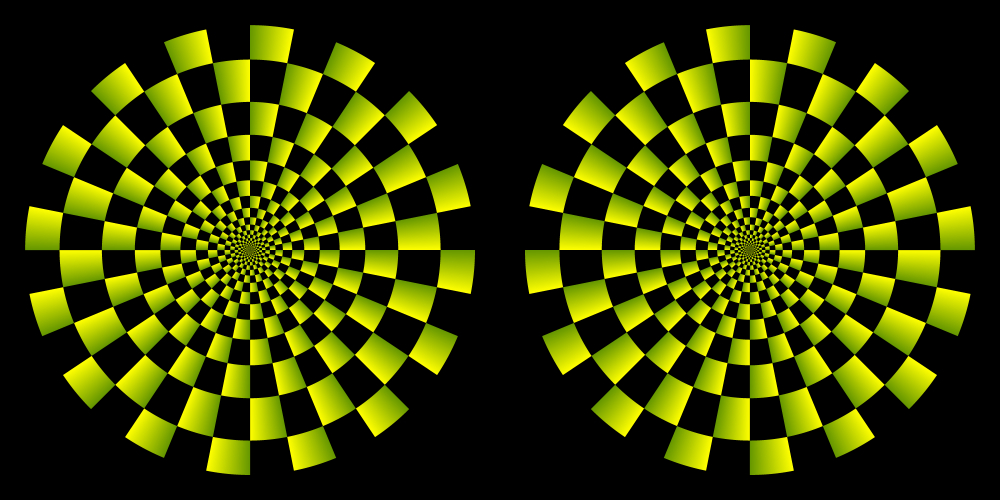
Observation 2. The illusion from light to dark is enhanced by yellow or green.
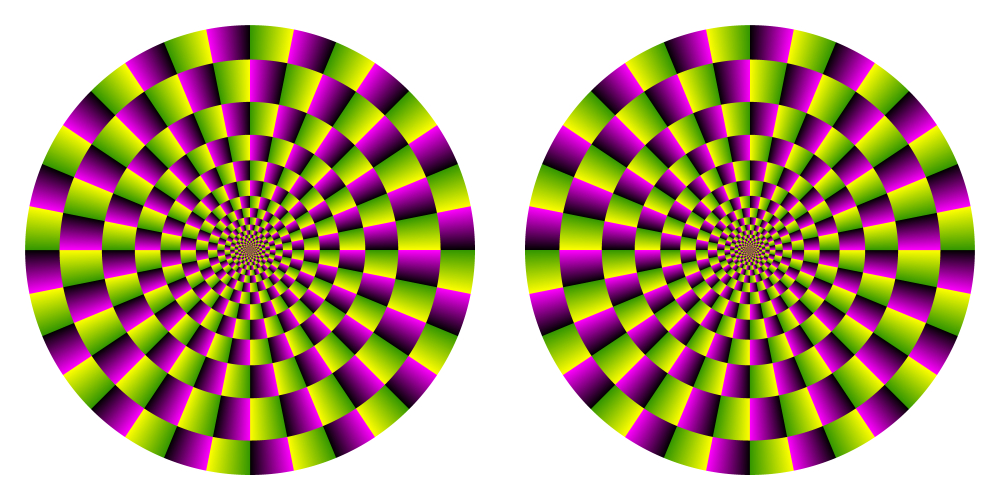
Observation 3. The illusion from dark to light is enhanced by red or blue, while the illusion from light to dark is enhanced by yellow or green. Both illusions work additively.
A work "U-zu-maki" I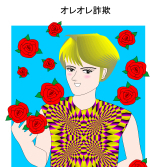 created in 2003's spring got so popular on Internet that I produced "Rotating
snakes" in 2003's autumn.
created in 2003's spring got so popular on Internet that I produced "Rotating
snakes" in 2003's autumn.
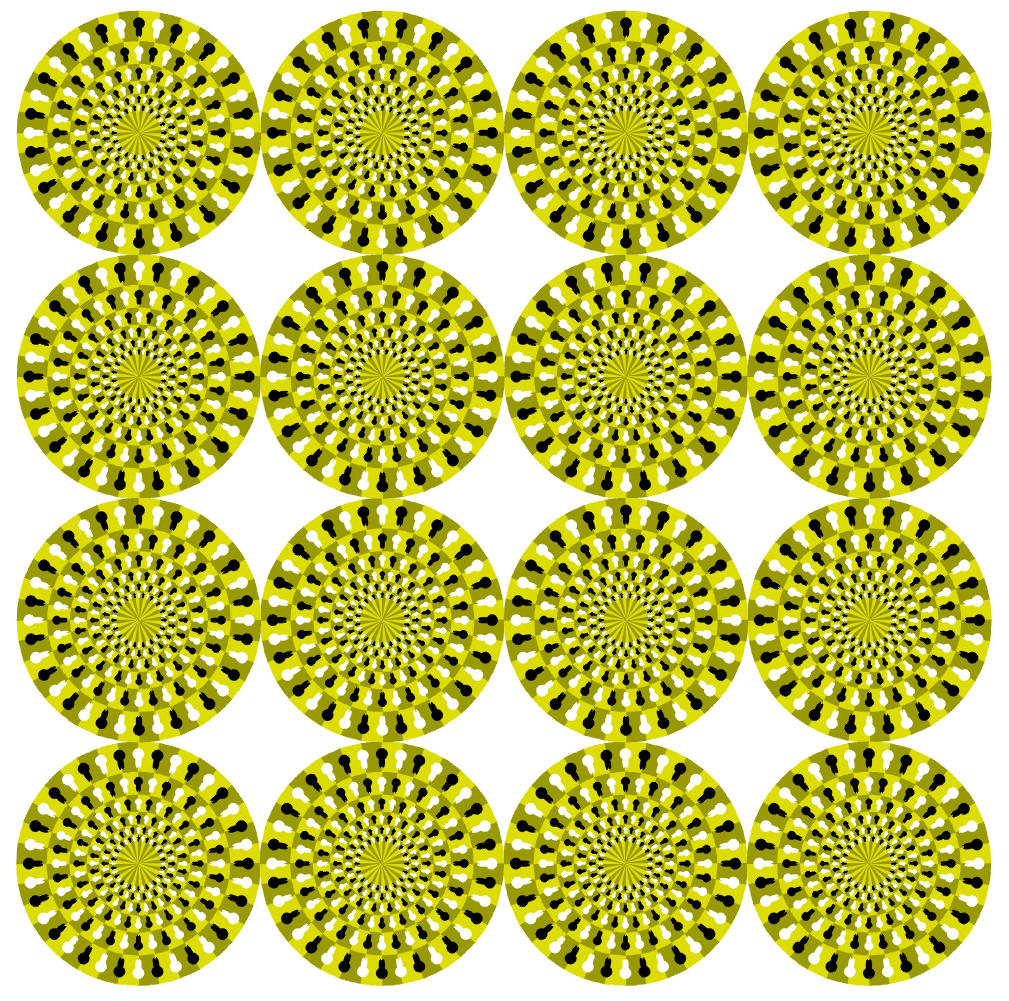
"U-zu-maki"
"U" means rabbits, "zu" means "figure", "maki" means rotation, and "Uzumaki" means spirals or swirls. Yellow represents the color of the moon in Japan and it is imagined (though not seriously) that rabbits live in the moon and make mochi (food made from rice).
Copyright
A.Kitaoka 2003
(c)Akiyoshi Kitaoka "Trick eyes 2"
Tokyo: KANZEN 2003
"Trick Eyes" and "Trick Eyes 2"
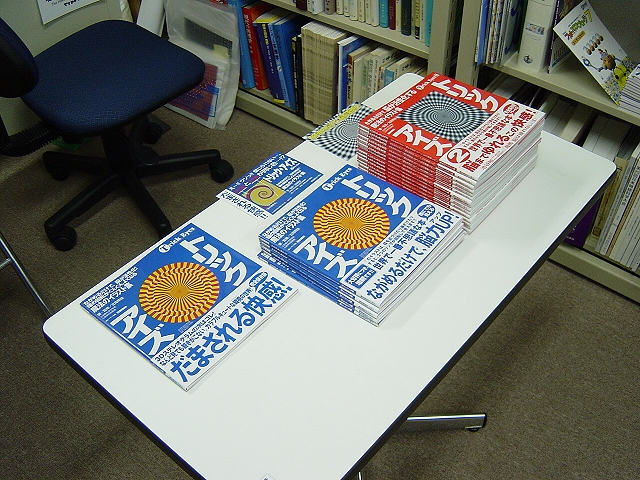
The back covers of "Trick Eyes" and "Trick Eyes 2"
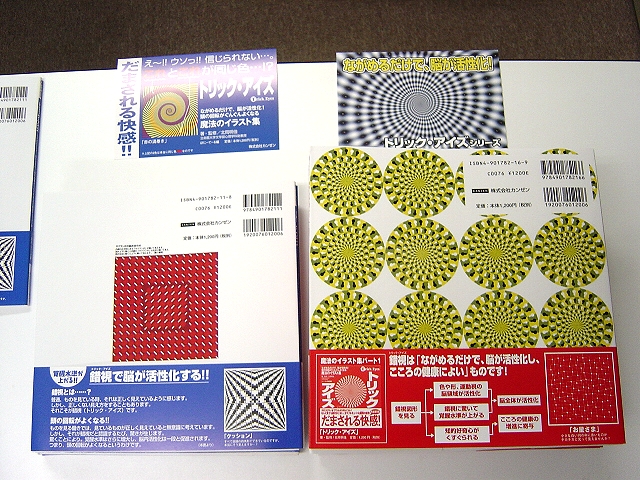

"Rotating snakes"
Circular snakes appear to rotate 'spontaneously'.
Copyright A.Kitaoka 2003 (September 2, 2003)
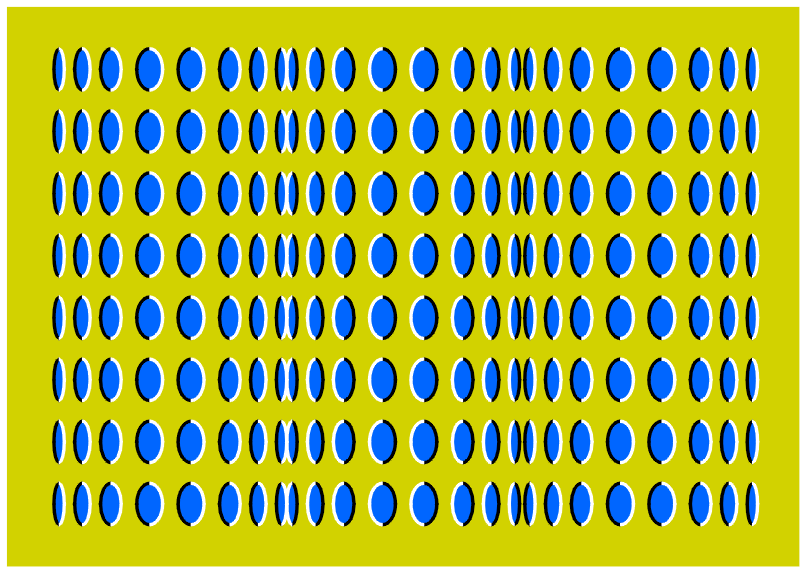
"Rollers"
Rollers appear to rotate without effort. On the other hand, they appear to rotate in the opposite direction when observers see this image keeping blinking.
Copyright A.Kitaoka 2004 (April 20)
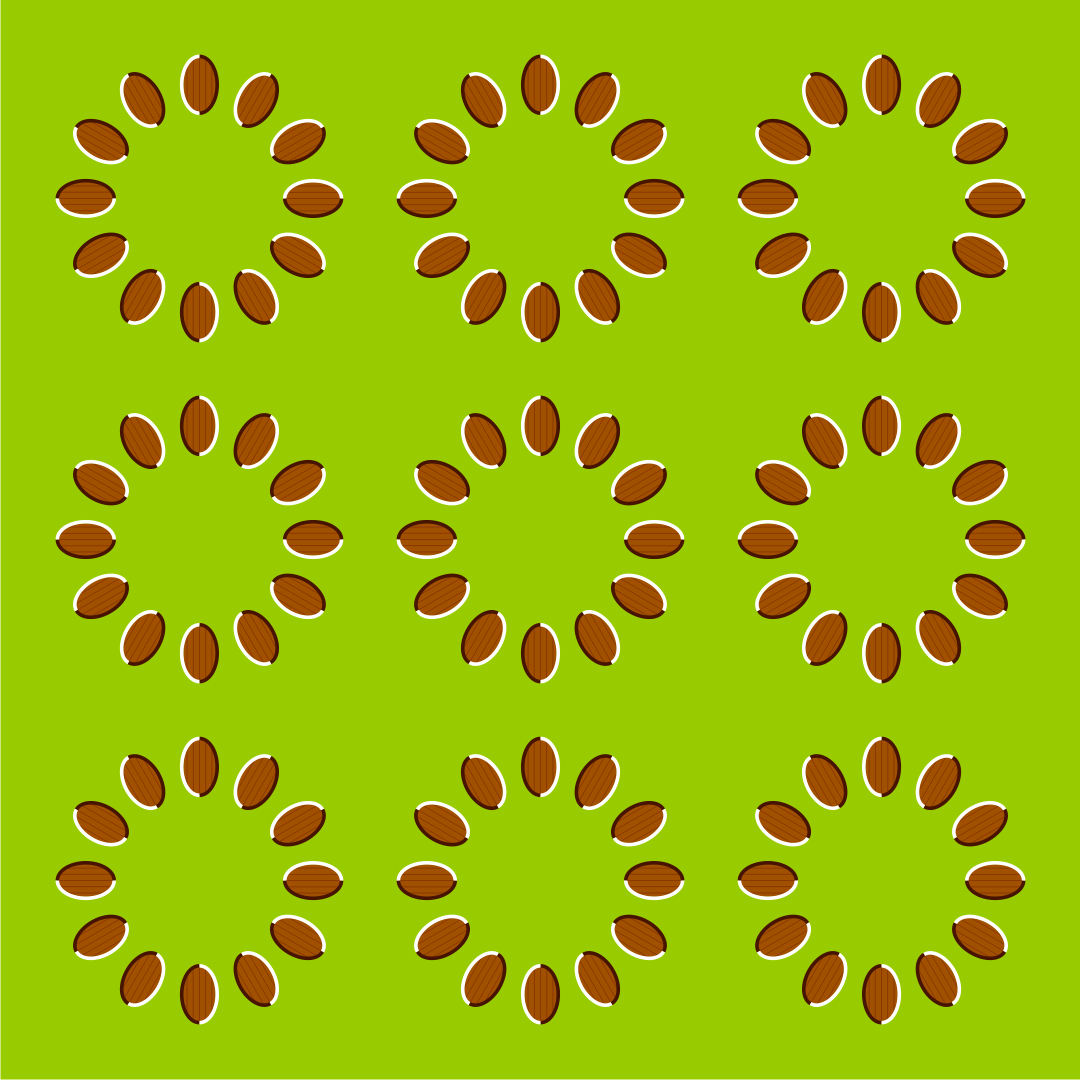
"Dongururin"*
*Rotation of donguri (acorns). "Gururin" means rotation.
Rings of donguri appear to rotate.
Copyright A.Kitaoka 2003 (July 3, 2003)
| Type | Basic illusion that motion direction is from dark to light |
Basic illusion that motion direction is from light to dark |
Examples (click the thumbnail) |
| IIa |   |
  |
 |
Here I  realized a similarity in stimulus configuration between Type IIa and reverse phi (or Gregory and Heard's (1983) phenomenal phenomena), and I made Type IIb to match Anstis and Rogers' (1975) "phi movement".
realized a similarity in stimulus configuration between Type IIa and reverse phi (or Gregory and Heard's (1983) phenomenal phenomena), and I made Type IIb to match Anstis and Rogers' (1975) "phi movement".
Reverse phi
Anstis S M, 1970 "Phi movement as a subtraction process" Vision Research 10 1411-1430
Gregory and Heard's (1983) phenomenal phenomena
Gregory R L, Heard P F, 1983 "Visual dissociations of movement, position, and stereo depth: Some phenomenal phenomena" Quarterly Journal of Experimental Psychology 35A 217-237
Anstis and Rogers' (1975) "phi movement"
Anstis S M, Rogers B J, 1975 "Illusory reversal of visual depth and movement during changes of contrast" Vision Research 15 957-961
The relationship between luminance changes and illusory motion
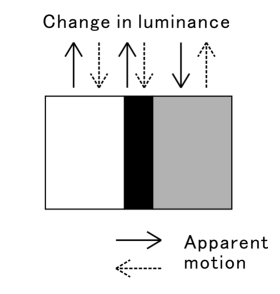


Kitaoka, A. (2006) Configurational coincidence
among six phenomena: A comment on van Lier and Csatho (2006). Perception,
35, 799-806. ![]() animations
animations
| Type | Basic illusion that motion direction is from dark to light |
Basic illusion that motion direction is from light to dark |
Examples (click the thumbnail) |
| IIb |   |
  |
Some works of mine could not be attributed to Type I or II. Thus I made Type III just before
going to VSS2007.
could not be attributed to Type I or II. Thus I made Type III just before
going to VSS2007.
Kitaoka, A. (2007) Phenomenal classification of the optimized Fraser-Wilcox illusion and the effect of color. Poster presentation in DemoNight,VSS2007, GWiz, Sarasota, Florida, USA, May 14, 2007.

"Receding color"
Each of the round-cornered, illusory square appears to contract.
Copyright
A.Kitaoka 2004 (June 11)
| Type | Basic illusion that motion direction is from dark to light |
Basic illusion that motion direction is from light to dark |
Examples (click the thumbnail) |
| III |   |
  |
Recently (August, 2008), I  realized a strong motion illusion when an image is changed to give a 3D
impression using the "plastic" effector equipped in Corel PhotoPaint
X3.
realized a strong motion illusion when an image is changed to give a 3D
impression using the "plastic" effector equipped in Corel PhotoPaint
X3.

Scintillating grid illusion
Schrauf, M., Lingelbach, B., Wist, E.R. (1997) The scintillating grid illusion. Vision Research, 37, 1033-1038.
![]()
3D-like scintillating grid illusion
Copyright Akiyoshi Kitaoka 2008 (August 22)
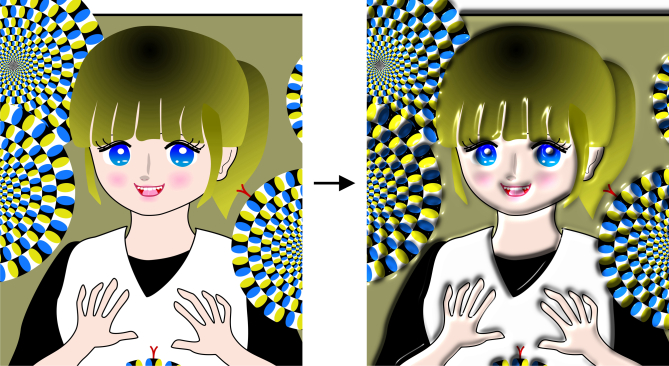
This effector makes a manga face fall into the uncanny valley.
"Bean wave"
The image appears to wave.
Copyright Akiyoshi Kitaoka 2008 (June 17)
![]()
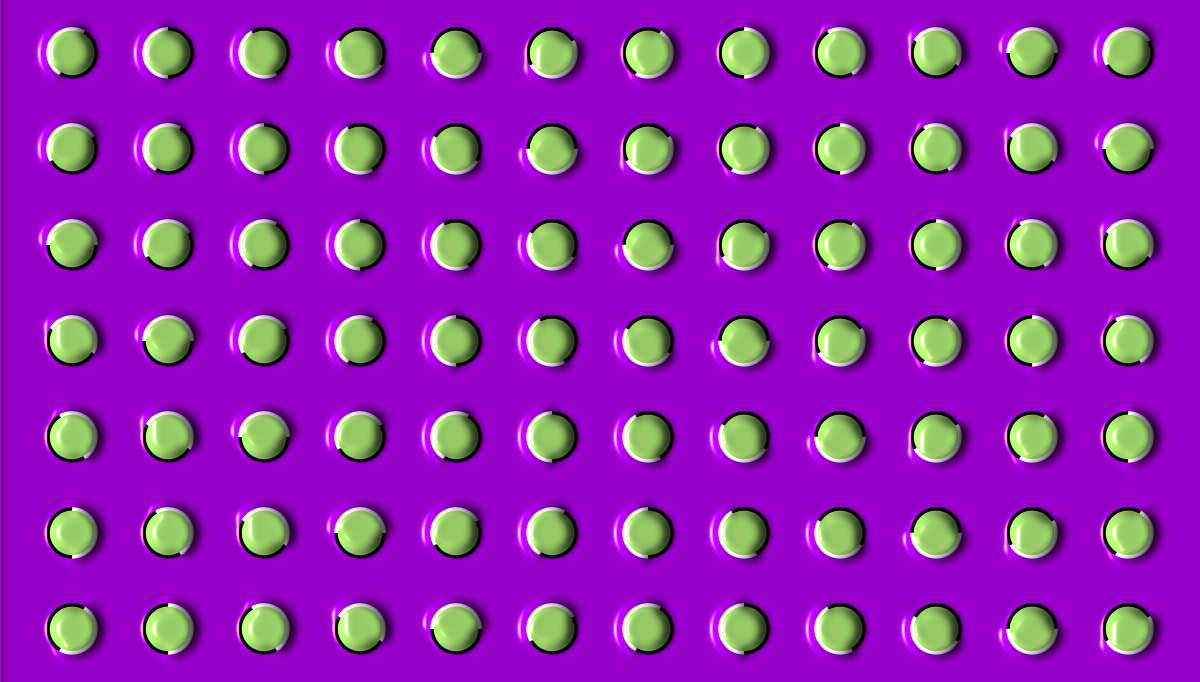
"Beans"
Beans appears to move rightward.
Copyright Akiyoshi Kitaoka 2008 (August 14)
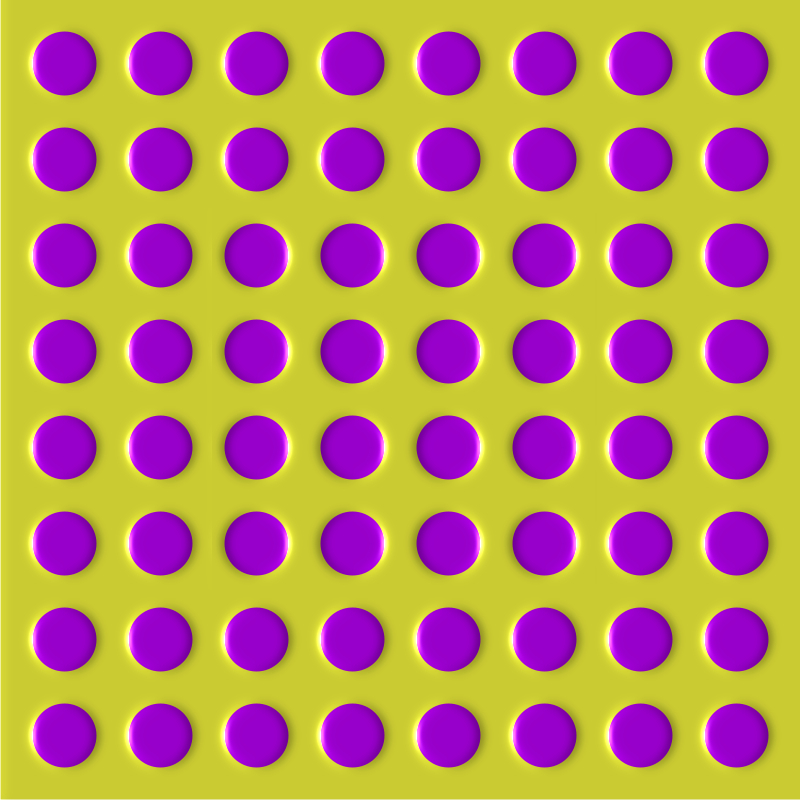
"Moving
patches"
The sixteen patches in the center appear to move rightward.
Copyright Akiyoshi Kitaoka 2008 (August 16)
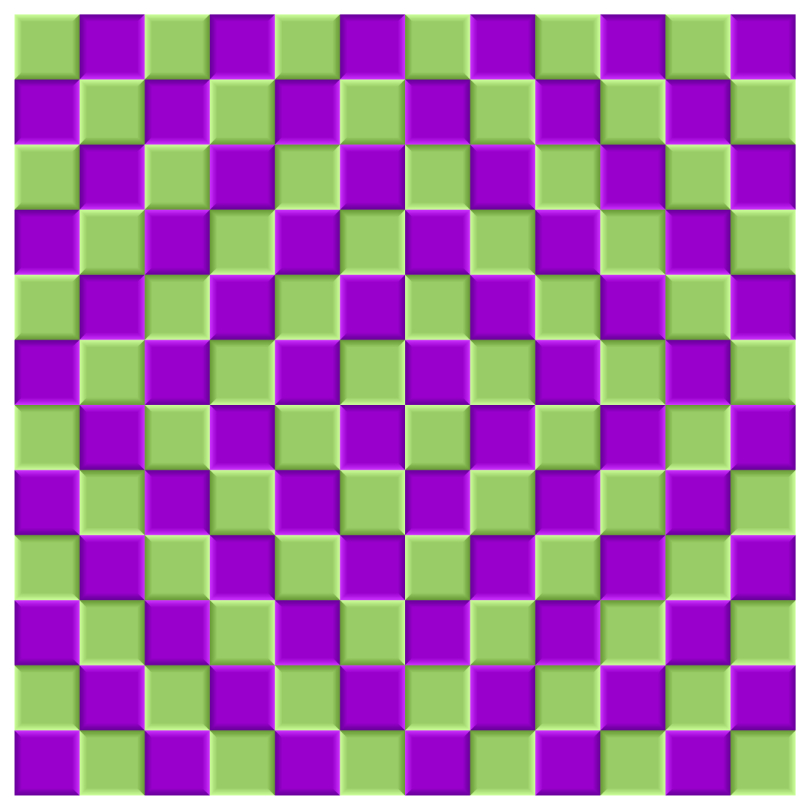
"Fountain of grapes"
The center of this image appears to be bulging.
Copyright Akiyoshi Kitaoka 2008 (September 15)
| Type | Basic illusion that motion direction is from dark to light |
Basic illusion that motion direction is from light to dark |
Examples (click the thumbnail) |
| IV new! |
  |
  |
 |
Thank you
| WS005 | Experimental studies of anomalous motion illusions | September 19, 2008 10:00-12:00 E207 |
|||||||
| Organizer | Kyoto University | Hiroshi | ASHIDA | ||||||
| Organizer | Ritsumeikan University | Akiyoshi | KITAOKA | ||||||
| Moderator | Kyoto University | Hiroshi | ASHIDA | ||||||
| Speaker | Optimized Fraser-Wilcox illusions: A pictorial classification by Akiyoshi Kitaoka | Ritsumeikan University | Akiyoshi | KITAOKA | |||||
| Speaker | The effects of eccentricity and retinal illuminance on the illusory motion seen in a stationary luminance gradient | University of Tokyo | Rumi | HISAKATA | |||||
| Speaker | Infants see the illusory motion in the static figure | Japan Women's University | So | KANAZAWA | |||||
| Speaker | Functional brain imaging of the Rotating Snakes illusion by fMRI | Tohoku University | Ichiro | KURIKI | | ||||
| Commentator | Some comments | NTT Communication Science Laboratories | Tatsuto | TAKEUCHI | |||||